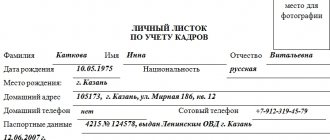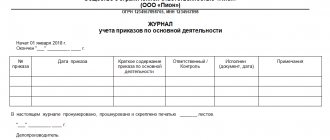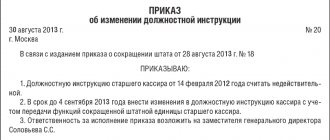For employees, the employer's order is binding. If it is legal, i.e. does not violate the law. And it is precisely non-compliance with the mandatory requirements of the law that becomes the basis for complaints to the labor inspectorate and appeals to the court.
If on the website you did not find the document required for your activity (an order for hiring, dismissal, granting leave, etc. is presented), the order can be drawn up according to the following example.
:
Employer's order
Example of an employer's order
Limited Liability Company "KinoFint"
December 08, 2021 Rostov-on-Don
Order No. 177
Due to the need to develop and approve the Procurement Plan in accordance with Federal Law dated July 18, 2011 No. 223-FZ,
I DEMAND:
- Structural divisions of KinoFint LLC, by December 14, 2021, must submit to the head of the procurement department, Maria Viktorovna Spherova, a list of goods, works and services necessary for KinoFint LLC employees to carry out their labor duties in accordance with the employment contract in 2021.
- The heads of structural units (according to the list attached to this order) should appoint those responsible for the implementation of this appendix and take control of the deadlines for fulfilling the requirements of the order.
- The head of the procurement department, Maria Viktorovna Sferova, must submit to the General Director of KinoFint LLC a procurement plan for KinoFint LLC for 2022, drawn up in accordance with the requirements of the legislation of the Russian Federation, by December 20, 2021.
- I reserve control over the implementation of this order.
Appendix: list of structural divisions
sheet for familiarization with this order
Deputy General Director Yakovlev Yakovlev S.P.
https://youtu.be/vG6BEE4El3Y
By personnel
This group occupies a separate niche. It has its own rules for drafting; moreover, there are unified forms of such documents, which should now be used everywhere. They can be issued for one single action and relate to: registration for work, transfer, dismissals and business trips. However, the number of people affected by this action is not limited.
The structure of such a document on personnel:
- Name of the organization;
- drafter of the document;
- title "Order";
- creation date and number;
- place of publication and title;
- text in two blocks;
- signature;
- executive visas are mainly for deputy heads of human resources;
- a note about familiarization with the order. The HR Officer is responsible for this;
- note about the responsible person.
These must be numbered throughout the year, the number is indicated with the mark “k” - this means personnel or “l / s”, which can be deciphered as personnel.
https://youtu.be/oG5Wzy0g3hQ
What is the difference between an employer’s order and an order?
The answer to this question is more theoretical. From a practical point of view, it is worth recognizing that the differences are not obvious. Of course, labor law theorists will find signs and features of each document. For example, with the help of an order, legal issues are resolved, and an order regulates organizational issues. What about the order to go on a business trip? Isn't this a question of labor organization? Or they call the difference: the order has a long term, and orders are limited in time. Also a controversial difference.
But even the Labor Code (Article 68, for example) uses these terms as equivalent. Although one difference is still “obvious”. The employer's order cannot be oral. A simple order from a manager is sometimes expressed verbally.
Forms of orders for main activities
Russian enterprises actively use unified personnel orders based on forms approved in various sources of law. The main one is Goskomstat Resolution No. 1, which was issued by the department on January 5, 2004. The following main types of orders for personnel are distinguished, as defined by the relevant Resolution:
- on the admission of an employee (it is drawn up on the basis of a unified form T-1 or T-1a, the first is personal, the second is consolidated);
- on the transfer of an employee (forms T-5, T-5a);
- about the employee going on vacation (documents T-6, T6a);
- on termination of the contract (forms T-8, T-8a);
- on the secondment of a specialist (documents T-9, T-9a);
- on employee incentives (forms T-11, T11-a).
It is worth noting that in the document flow of enterprises, their own forms of orders can also be used, unless prohibited by law. This is also possible if a particular sample order for personnel in the form of a unified form is not approved by law.
If a company draws up this or that document independently, it is recommended to apply the provisions of a special state standard, GOST R 6.30-2003. What might a unified order for personnel look like? An example of such a document is in the picture below.
In this case, we are considering a sample employment order using the unified form No. T-1.
Unified forms of orders are most often used in budgetary organizations, as well as in state enterprises. In many cases, this is due to the availability of approved departmental source samples.
In turn, private companies quite often use their own order forms. But, as a rule, only in cases where a unified document has not been approved to solve the problems of the personnel service. If they are in circulation, then usually enterprises do not waste time creating new forms, which, in fact, will duplicate the unified ones. Which are also characterized by a fairly high degree of convenience, in terms of structure.
What might sample personnel orders developed by a company independently look like? An example of one of them is in the following picture.
In this case, a sample order for approval of the vacation schedule is considered. It is usually presented in a fairly simple structure.
Note that usually enterprises have no particular reason to replace standardized forms with internal corporate samples - unless the company has particularly complex production formats that require the establishment of separate accounting mechanisms. Or, if their structure is quite simple - as is the case with the vacation schedule.
It may be noted that there are quite a few criteria for classifying the orders in question. Among these is the structure of the document. Let's take a closer look at its features.
Contents of the employer's order
Among personnel workers, there is an opinion that the employer should not justify the order in terms of reference to legal norms. Lawyers, we think, will not agree with this point of view. Any administrative act must be supported by legal norms.
Therefore, we recommend sticking to the following structure:
- employer's name
- date, place of drawing up the document, its type - Order
- grounds for issuing an order
- the actual administrative part - I oblige, demand, order, appoint, etc.
- control over compliance with the requirements of the document, signature with transcript of the person who issued the document.
The text of the employer’s order must be brought to the attention of interested employees against signature.
Development of a draft order
After the information has been collected, competent specialists directly develop a draft order for personnel. Solving this problem requires, first of all, the correct execution of the document. It is advisable to indicate in it that it is a project, a sample order for personnel, that is being developed, and not an official local legal act. That is, write the word “project” on the document. However, the text in the source should be given as close as possible to what should be present in the official order. It is possible that a competent manager will pre-approve the text of the document in its original form.
If the order - in form, as well as in content, is agreed upon - immediately or with adjustments, then it can be sent for signing. What is this procedure?
Rules for creating a form
Before preparing an order on staff reduction or other issue, you should understand what it is and what processes it regulates.
Its primary purpose is to organize work activities carried out directly by the manager, although often this function is assigned to his representative, who is the secretary or deputy.
The responsible person must understand the structure according to which these documents must be drawn up, what features different papers have, and for how long the completed forms will need to be stored.
There are three types of internal orders that can be issued:
| By main activity | — |
| By personnel | This includes the hiring of people, their dismissal, referral for certification or advanced training, decisions on incentives, assignment of titles, transition to combining positions, etc. |
| To resolve administrative and economic issues | Providing utilities, establishing communications or purchasing necessary supplies |
Separately, it is worth mentioning personnel orders, the main task of which is to reflect management decisions that relate to the company’s personnel policy.
Thus, orders relating to labor relations belong to this group, since they reflect all aspects of hiring, dismissal, transfer to other positions, issuing incentives and sanctions.
Until 2013, order forms were approved by the State Statistics Committee and were unified, but if GOST was not used, then it could be generated in free form.
From this period, the forms of a unified nature are no longer valid, and they are subject to the general procedure.
Organizations can approve any convenient type of document to become official, and this usually happens with papers that were previously official at the state level.
But organizational and administrative documents, that is, orders for the economic part and the main line of activity, have always been drawn up in free form, and at the moment this has not changed.
The organization's Office Management Instructions talk about how orders should be prepared, and it says that all decisions regarding internal work should be made in this format.
Projects are prepared by structural divisions, but are signed either by the general director or deputy.
If the department took the initiative by developing the text, then the paper must contain the essence of the proposal, justification of the need, as well as the grounds for implementation.
How to issue an order for approval of office management instructions
The paperwork is prepared by the enterprise's records management service with the participation of an archivist and legal adviser. In structural units, the provision is used as the main local act that specialists will use when working with correspondence.
The country's regulatory framework does not have a unified form for this type of document. The manager has the right to adhere to his own rules that comply with internal policy and do not contradict the law.
The order may be issued on company letterhead. At the top of the sheet is written the full name of the company, legal address, and registration codes. This is followed by a field for the journal number and the date the order was signed. On the right side of the sheet the name of the locality where the company is located is indicated.
The document is headed with the word “ORDER”, followed by a preamble. Here the performer indicates the grounds for publication. In the case under consideration, this will be GOST R ISO 15489-1-2007. At the time of publication of the article, the country’s regulatory framework may have undergone changes; therefore, the contractor should check official sources of information and bring the project into compliance with the amendments.












